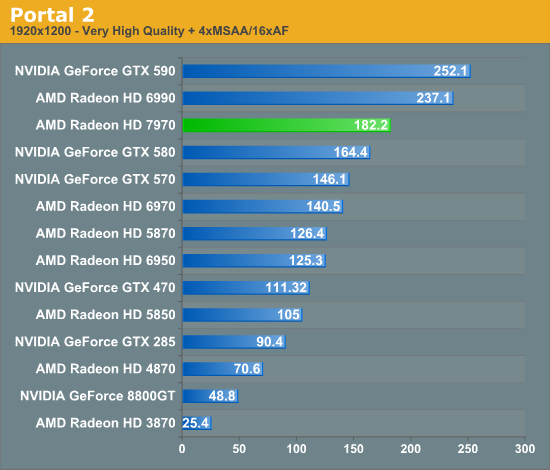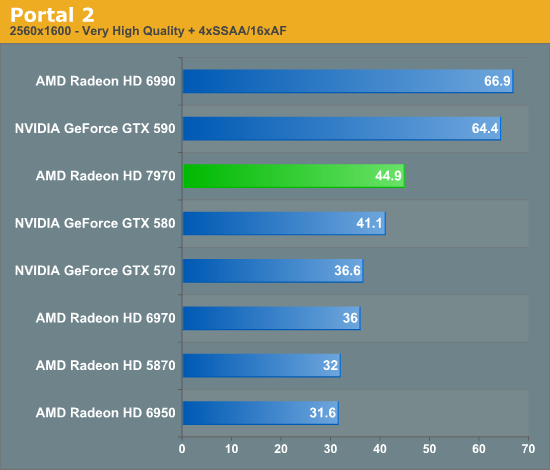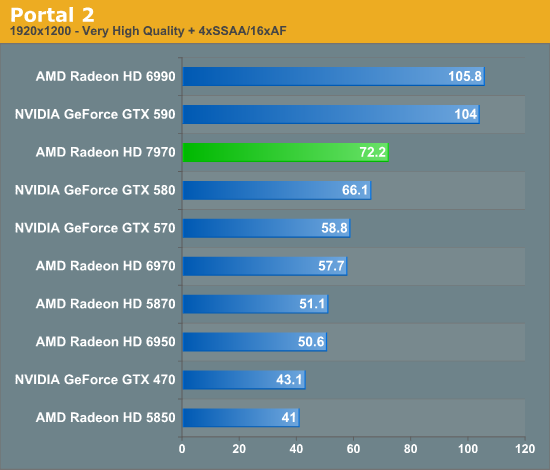AMD Radeon HD 7970 Review: 28nm And Graphics Core Next, Together As One
by Ryan Smith on December 22, 2011 12:00 AM EST- Posted in
- GPUs
- AMD
- Radeon
- ATI
- Radeon HD 7000
Portal 2
Portal 2 continues the long and proud tradition of Valve’s in-house Source engine. While Source continues to be a DX9 engine, Valve has continued to upgrade it over the years to improve its quality, and combined with their choice of style you’d have a hard time telling it’s over 7 years old at this point. Consequently Portal 2’s performance does get rather high on high-end cards, but we have ways of fixing that…


Given Portal 2’s wide range of performance it’s possible to at least somewhat bog it down on the GPU side without any special tricks thanks to its heavier use of shaders than in past Valve titles. Given a fast enough card I believe we could hit the 300fps internal Source framerate cap on our testbed, but thankfully at 2560 we’re nowhere close. In any case at 2560 the 7970 is well into the stratosphere, delivering 128.9fps, which is 18% better than the GTX 580. Meanwhile at 1920 as with so many other benchmarks that lead shrinks, this time down to 11%. Meanwhile the 7970 enjoys a smaller lead over the 6970, beating it by only around 30% at either resolution.


The great thing about the Source engine is that it’s well studied, and by utilizing DirectX9 it’s open to a few more image quality enhancements than DX10+ games. We’ve always wanted to have a standard benchmark with more anti-aliasing than just MSAA, and Portal is the perfect candidate. So for the second part of this test, we’ve turned on Super Sample Anti-Aliasing (SSAA) through NVIDIA and AMD’s driver control panels. With SSAA the entire scene gets anti-aliased, going beyond just removing the jaggies at polygon edges and removing all signs of shader aliasing too, making Portal 2 a very good looking game.
As expected, SSAA makes the performance of everything tank. At 2560 the 7970 is well below 60fps, and every other single-GPU card is slower yet. Once we get down to 1920 performance finally reaches a point where it’s playable, as the 7970 reaches 72.2fps.
Compared to its competition, it’s interesting to note that we appear to have hit an entirely different set of bottlenecks by using SSAA. The 7970 leads the GTX 580 by 9% at both resolutions while it leads the 6970 by 25% under the same conditions. We believe that at this point we’re seeing the limitations of ROP performance, which would explain why the 7970’s lead diminishes versus both the GTX 580 and 6970. The additional bandwidth the 7970’s design affords the ROPs can only go so far until it once again becomes a matter of pixel pushing power.










292 Comments
View All Comments
CrystalBay - Thursday, December 22, 2011 - link
Hi Ryan , All these older GPUs ie (5870 ,gtx570 ,580 ,6950 were rerun on the new hardware testbed ? If so GJ lotsa work there.FragKrag - Thursday, December 22, 2011 - link
The numbers would be worthless if he didn'tAnand Lal Shimpi - Thursday, December 22, 2011 - link
Yep they're all on the new testbed, Ryan had an insane week.Take care,
Anand
Lifted - Thursday, December 22, 2011 - link
How many monitors on the market today are available at this resolution? Instead of saying the 7970 doesn't quite make 60 fps at a resolution maybe 1% of gamers are using, why not test at 1920x1080 which is available to everyone, on the cheap, and is the same resolution we all use on our TV's?I understand the desire (need?) to push these cards, but I think it would be better to give us results the vast majority of us can relate to.
Anand Lal Shimpi - Thursday, December 22, 2011 - link
The difference between 1920 x 1200 vs 1920 x 1080 isn't all that big (2304000 pixels vs. 2073600 pixels, about an 11% increase). You should be able to conclude 19x10 performance from looking at the 19x12 numbers for the most part.I don't believe 19x12 is pushing these cards significantly more than 19x10 would, the resolution is simply a remnant of many PC displays originally preferring it over 19x10.
Take care,
Anand
piroroadkill - Thursday, December 22, 2011 - link
Dell U2410, which I have :3and Dell U2412M
piroroadkill - Thursday, December 22, 2011 - link
Oh, and my laptop is 1920x1200 too, Dell Precision M4400.My old laptop is 1920x1200 too, Dell Latitude D800..
johnpombrio - Wednesday, December 28, 2011 - link
Heh, I too have 3 Dell U2410 and one Dell 2710. I REALLY want a Dell 30" now. My GTX 580 seems to be able to handle any of these monitors tho Crysis High-Def does make my 580 whine on my 27 inch screen!mczak - Thursday, December 22, 2011 - link
The text for that test is not really meaningful. Efficiency of ROPs has almost nothing to do at all with this test, this is (and has always been) a pure memory bandwidth test (with very few exceptions such as the ill-designed HD5830 which somehow couldn't use all its theoretical bandwidth).If you look at the numbers, you can see that very well actually, you can pretty much calculate the result if you know the memory bandwidth :-). 50% more memory bandwidth than HD6970? Yep, almost exactly 50% more performance in this test just as expected.
Ryan Smith - Thursday, December 22, 2011 - link
That's actually not a bad thing in this case. AMD didn't go beyond 32 ROPs because they didn't need to - what they needed was more bandwidth to feed the ROPs they already had.